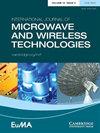用于认知无线电和6ghz以下5G新无线电应用的频率可重构双元MIMO天线
IF 1.3
4区 计算机科学
Q3 ENGINEERING, ELECTRICAL & ELECTRONIC
International Journal of Microwave and Wireless Technologies
Pub Date : 2023-11-08
DOI:10.1017/s1759078723001289
引用次数: 0
摘要
本文提出并讨论了一种适用于6ghz以下5G新型无线电的紧凑型双元可重构多输入多输出(MIMO)天线。MIMO天线具有四种频率工作模式:宽带工作模式(2.41 - 6 GHz)、陷波频带为3.5 GHz (3.2-3.66 GHz)的宽带工作模式、滤除较高频率的低通滤波模式(2.41 - 4.7 GHz宽工作频带)和双频段工作模式(2.41 - 3.16 GHz和3.64-4.7 GHz)。为了提高整个工作频带的隔离性,使用了一条带状线连接两个天线单元的两个接地面。为了验证所提出的方法,已经制作和测量了不同的原型。仿真结果与实测结果吻合较好。该天线具有良好的MIMO分集性能,最大增益为4.64 dBi。四种工作模式的最小隔离度为18 dB,而测量的包络相关系数小于0.008。在各种工作模式下,分集增益接近10 dB。该天线适用于认知无线电和5G sub- 6ghz应用。本文章由计算机程序翻译,如有差异,请以英文原文为准。
Frequency reconfigurable two-element MIMO antenna for cognitive radio and 5G new radio sub-6 GHz applications
Abstract In this paper, a compact two-element reconfigurable multiple-input multiple-output (MIMO) antenna for 5G new radio sub-6 GHz is presented and discussed. The proposed MIMO antenna has four frequency operating modes: a wideband operating mode (2.41–6 GHz), a wideband operating mode with a notching band at 3.5 GHz (3.2–3.66 GHz), a low-pass filter mode that filters the higher frequencies with a wide operating band from 2.41 GHz to 4.7 GHz, and a dual-band mode with two operating narrow bands (2.41–3.16 GHz and 3.64–4.7 GHz). To improve the isolation over the entire operating band, a strip line connecting the two ground planes of the two antenna elements has been used. To validate the proposed approach, different prototypes have been fabricated and measured. The simulation results are in good agreement with the measurement results. The proposed antenna has good MIMO diversity performance with a maximum gain of 4.64 dBi. The minimum isolation is 18 dB for the four operating modes, while a measured envelope correlation coefficient of less than 0.008 is achieved. The diversity gain is near 10 dB for various operating modes. The antenna is suitable for cognitive radio and 5G sub-6 GHz applications.
求助全文
通过发布文献求助,成功后即可免费获取论文全文。
去求助
来源期刊

International Journal of Microwave and Wireless Technologies
ENGINEERING, ELECTRICAL & ELECTRONIC-TELECOMMUNICATIONS
CiteScore
3.50
自引率
7.10%
发文量
130
审稿时长
6-12 weeks
期刊介绍:
The prime objective of the International Journal of Microwave and Wireless Technologies is to enhance the communication between microwave engineers throughout the world. It is therefore interdisciplinary and application oriented, providing a platform for the microwave industry. Coverage includes: applied electromagnetic field theory (antennas, transmission lines and waveguides), components (passive structures and semiconductor device technologies), analogue and mixed-signal circuits, systems, optical-microwave interactions, electromagnetic compatibility, industrial applications, biological effects and medical applications.
 求助内容:
求助内容: 应助结果提醒方式:
应助结果提醒方式:


